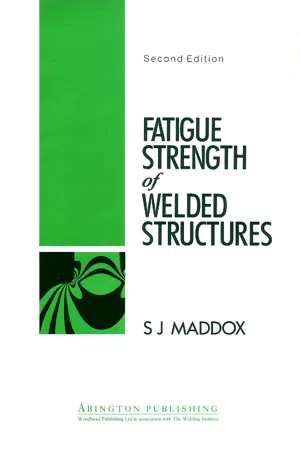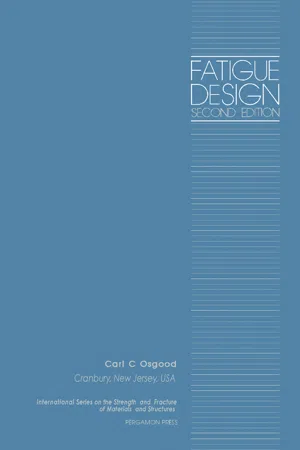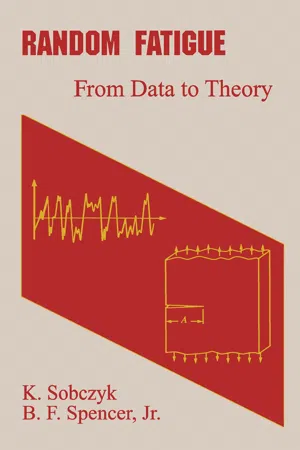Technology & Engineering
Miner's Rule
Miner's Rule is a widely used empirical method in engineering to predict the fatigue life of a material under cyclic loading. It states that the total damage caused by a combination of stress cycles is equal to the sum of the damage caused by each individual cycle. This rule helps engineers to estimate the life of a material and design structures that can withstand cyclic loading.
Written by Perlego with AI-assistance
Related key terms
1 of 5
5 Key excerpts on "Miner's Rule"
- eBook - PDF
- S J Maddox(Author)
- 2014(Publication Date)
- Woodhead Publishing(Publisher)
It may be noted that N ; can be expressed in terms of S; and the con-stants m and A given in Table 2 A S: m 14] so that Miner's Rule could be stated as E S i m n i = A at failure, or S S : m n : > = A for survival [5] Note that the fatigue damage due to a block of nj cycles at is propor-tional to S i m n i . The application of Miner's Rule is discussed further in Appendix 1. Many investigations have been carried out to test the validity of Miner's Rule and there is some diversity in the values of £ Jl (which should be unity at failure if the rule is correct) actually obtained. Until log, (stress range GO M -» 1 Damage as a result of Si proportional to n-j/N-, Damage as a result of Si proportional to n-j/N-, N, N 2 N 3 log, (life) 14 A p p l i c a t i o n o f Miner's Rule. Practical applications of the rules 119 relatively recently, most tests were performed under block programme loading (Fig. 15). This type of loading is a simplification of actual serv-ice loading, containing the same mix of stress ranges and the number of times they occur but applying them in blocks of constant stress range. The results of block programme load fatigue tests have indi-cated that, in general, Miners rule is safe > 1 a t failure of the test specimen). Tests performed under more realistic spectrum loading conditions (e.g. simulating or even reproducing spectra of the type illustrated in Fig. 13) have also increased confidence in the use of Miner's Rule. In particular, if the applied stress spectrum is one con-taining occasional relatively high tensile stresses ('overloads'), the fatigue life can greatly exceed that estimated using Miner's Rule, because of the occurrence of'crack growth retardation'. This phenom-enon is thought to stem from the introduction of compressive residual stresses at the fatigue crack tip. - eBook - PDF
Fatigue Design
International Series on the Strength and Fracture of Materials and Structures
- Carl C. Osgood, D. M. R. Taplin(Authors)
- 2013(Publication Date)
- Pergamon(Publisher)
Moreover, a body of experience has been built up which enables an estimate to be made of the error to be expected in any set of circumstances. 3.2.1 THE LINEAR, OR MINER, RULE It appears that the Miner rule arose from efforts to reduce available information and data on fatigue behavior to design practice. In 1945 Miner commented that progress with methods of fatigue analysis had been slow because of lack of basic information on material, and more important, because no method of handling any but the simplest problem had been available (i.e., the direct use of an S-N curve). Any solution requires several tools before one can make other than a simple com-parison based on tests; even in comparative tests, the experiment may be easily oversimplified to the extent that significant effects are lost. These tools must provide the following: 1. Information on the loading conditions: level, frequency of occurrence, number of cycles, and so forth. 2. A method of relating various loading cycles; that is, cycles of stress that have different ratios of minimum to maximum stress, as well as differences in mean stress level. 3. Information on the number of cycles to failure of the material or part at various stresses: S-N, or constant-life curves. 4. Means of evaluating the cumulative effects of cycles of stress at various levels. There was already a considerable background for these conclusions [29, 30, 43, 44]; it is to be noted that the concept of an accumulation of damage, however defined, during the period(s) of cyclic stressing was widely accepted. The argument arose over the rate of accumulation and the proper mathematical expression of a damage law. Miner f s approach was to formulate an expression that would meet the require-ments and accommodate the information listed above in the simplest possible manner. He assumed that the phenomenon of cumulative damage under cyclic stressing was related to the net work absorbed by the specimen. - eBook - PDF
Random Fatigue
From Data to Theory
- K. Sobczyk, B. F. Spencer Jr., B. F. Spencer, Jr.(Authors)
- 2012(Publication Date)
- Academic Press(Publisher)
While the absolute validity of the Palmgren-Miner rule is in ques-tion, its comparative usefulness as a simple criterion for comparing differ-ent designs of a structure is still of considerable value. 3.2 Nonlinear Damage Hypotheses To overcome the shortcomings of the Palmgren-Miner rule, a number of nonlinear damage hypotheses have been proposed. One of the first nonlin-ear damage rules was proposed by Marco and Starkey [33] and has the fol-lowing analytical form: where the exponent x s is a function of the stress level and is assumed to fall in the range between zero and one (with the value increasing with stress level); ,· denotes a damage fraction associated with stress amplitude S t . Failure, or 100 percent damage, is reached when the sum of · reaches a critical value. Analogous to the Palmgren-Miner rule, the values of N t are the lives to failure corresponding to S ( on the S-N curve. A deficiency of this approach is that the family of stress curves on the damage plot must be developed experimentally for a given material. (See Bannantine et al. [3].) When the exponent x s in Eq. (1.7) is independent of the stress condition (i.e., it is a constant value for all stress conditions), the damage specifica-tion (1.7) reduces to the so-called modified Miner rule. A modification of Miner's Rule referred to as Shanley's rule [43] is ex-pressed as follows: = cS kb n, (1.8) where is a damage resulting from n cycles applied at stress amplitude S. The quantity b is the shape parameter for the central portion of the S-N di-agram, whereas c and k are material constants (£> 1) . The aforemen- 3. Cumulative Damage Theories 15 tioned expression for damage differs from the previous ones in that it is a function of the number of applied cycles rather that the cycle ratio. A rule that is based on similar reasoning is known as the Corten-Dolan hypothesis [10]. - eBook - ePub
Advanced Aerospace Materials
Aluminum-Based and Composite Structures
- Haim Abramovich(Author)
- 2023(Publication Date)
- De Gruyter(Publisher)
Fig. 4.6 ) till it intercepts the Goodman line. From that point, it continues along the Goodman line.One should note that any combination of mean and alternating stresses under the corresponding lines (depending on which theory is chosen) would lead to the required number of cycles, and all those points above the lines would expect to fail earlier.Appendix A provides an example for the use of Fig. 4.6 and its associated eqs. (4.16 ), (4.17 ) and (4.18 ).Fig. 4.6: Constant life diagrams: combinations of σa and σm leading to the same fatigue life.4.4 Miner rule – the cumulative damage
In real life, a component or a structure might experience loads at variable amplitudes. Designing of fatigue for those structures is performed by the famous approach called Miner’s rule or Miner’s linear damage rule [38 ]. According to it, the fatigue damage D is found using the following equation:(4.19)D =+n 1N 1+n 2N 2+ ⋯ +n 3N 3=n iN i∑i = 1k≤ 1.0n iN iwhere n1 , n2 , n3, …, ni are the number of cycles at stresses S1 , S2 , S3 , …, Si expected during the life of the component, while N1 , N2 , N3 , …, Ni are the number of cycles at failure under constant load amplitude (see Fig. 4.7 for a typical example). For values less and/or equal to unity, no failure is expected. Values above unity will mean failure due to fatigue. Note that the failure cycle Ni should be obtained from a relevant component design S–N curve.Fig. 4.7: Schematic application of the Miner’s rule.One should be aware that the Miner’s rule does not account for the sequence of the stress ranges, but only for the number of stress ranges. To take this issue into account the design of the component should be more conservative, thus reducing the limiting damage to a value less than unity. - eBook - PDF
Product Design for the Environment
A Life Cycle Approach
- Fabio Giudice, Guido La Rosa, Antonino Risitano(Authors)
- 2006(Publication Date)
- CRC Press(Publisher)
The first concept (Palmgren, 1924) was subsequently translated into mathe-matical form by Miner, according to the law: D r n N i i fi ∑ ∑ (10.26) This is a Linear Damage Rule (LDR), based on the principle that for every loading cycle there is a constant absorption of energy and that every material has a characteristic value of absorbed energy to reach failure. According to Miner’s hypothesis, each cycle consumes a part of the residual life of the material (n i N fi ), even though it does not directly cause failure. When the sum of the individual damages reaches the value of 1 (i.e., r i 1), all the residual life of the component has been consumed and it breaks. This law can be demonstrated as follows. Knowing the Wöhler curve of a given material, a sample of this material is subjected to fatigue loading for a number n 1 of symmetrical alternating cycles with oscillation semiamplitude greater than the fatigue limit. If at this loading level the life of the sample, evaluated from the Wöhler curve, is equal to N 1 , the residual lifespan of the sample is given by the difference N 1 n 1 , the percentage of life consumed being equal to the ratio n 1 N 1 . Subjecting the same sample to a second load-ing of different amplitude, with which the life of the virgin sample would be N 2 , failure is reached after a number of cycles n 2 . If the percentage of residual life was N 1 n 1 /N 1 , this should equal n 2 /N 2 and, therefore: n N n N 1 1 1 2 2 (10.27) FIGURE 10.8 Damage curve according to Miner. 272 Product Design for the Environment In a graph of versus N, it is possible to plot the curve of residual life. As shown in Figure 10.8, this will essentially be parallel to the original curve. The main limitations to this theory are that it is independent of the loading level and sequence, as well as the loss of interaction between the different loads.
Index pages curate the most relevant extracts from our library of academic textbooks. They’ve been created using an in-house natural language model (NLM), each adding context and meaning to key research topics.




